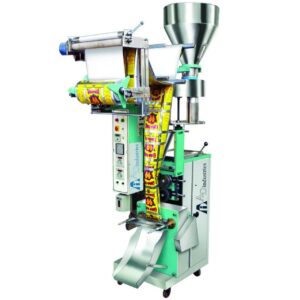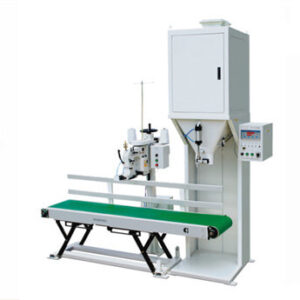Description
| Feature | Description |
|---|---|
| Model | XYZ-2000 |
| Capacity | 500 – 2000 grams |
| Filling Accuracy | ± 0.5% |
| Power Supply | 220V/50Hz |
| Power Consumption | 1.5 kW |
| Air Pressure | 0.4 – 0.6 MPa |
| Air Consumption | 0.6 m³/min |
| Filling Speed | 20 – 60 bags/min |
| Hopper Volume | 50 liters |
| Suitable Material | Powder, granules |
| Control System | PLC with touch screen interface |
| Material Contact Parts | Stainless steel SUS304 |
| Dimension (L x W x H) | 1200mm x 800mm x 1800mm |
| Weight | 500 kg |
| Packaging Type | Bags, pouches |
| Optional Features | Nitrogen flushing, dust collector, vibrating feeder |
| Safety Features | Emergency stop button, overload protection |
| Certification | CE, ISO9001 |
Introduction to Automatic Powder Filling Machine
The packaging industry has been transformed by automatic powder-filling machines through high accuracy, precision, and efficiency in filling powders. These complex equipment have different types that are designed for specific industries. Automatic powder fillers are critical in product quality control and streamlining the production process in fields such as pharmaceuticals, food, and cosmetics among others. These machines are now indispensable to manufacturers across the globe as they provide advanced features like speed, accuracy, and versatility. With further developments in technology, there is hope that future automatic powder-filling machines will be more efficient, customizable, and sustainable.
Types of Automatic Powder Filling Machines
Various types of automatic powder-filling machines exist each tailored to suit different industrial requirements and needs for production. Some of the common types are;
Auger Filling Machines: This machine makes use of auger screws for accurate dispensing of measured amounts of powdered substances. The auger rotates within a hopper collecting powder which it then discharges into containers with precision.
Volumetric Filling Machines: Volumetric fillers measure out a predetermined volume for dispensing powdered substances; they work well with products where exact weight is not a critical factor.
Weight-Based Filling Machines: Load cells or weighing scales are used by this machine to determine the weight of powder being dispensed hence providing a high level of accuracy essential for precise dosing applications.
Vacuum Filling Machines: Vacuum fillers depend on vacuum technology when filling containers with powdery materials. They can be used to fill lightweight or fluffy powders without creating airspace pockets.
How Automatic Powder Filling Machines Work
The working principle differs from one type to another but typically includes the following steps:
Feeding: manual feeding or introduction via an automated feeding system into a hopper fixed on top of the machine.
Dispensing: Into containers or packaging units using either pre-determined auger rotation, volumetric volume, or weight-based measurement.
Leveling: In some cases, this machine includes a leveling mechanism to make sure that the powder is evenly spread out within the container while minimizing air spaces for uniform filling.
Sealing: After being filled, the containers are sealed by the packaging specifications e.g. capping or heat sealing mechanisms.
Labeling and Packaging: The finished product containers are labeled and packaged based on their required industry standards as well as other specific product requirements.
Features and Functions of Automatic Powder Filling Machines
Automatic powder filling machines come with a variety of features and functions aimed at making filling easier and increasing efficiency. Some common ones include;
High-Speed Operation: Depending on the machine’s specifications and the type of powder being filled into them, automatic powder fillers can fill hundreds if not thousands of containers per hour.
Precision Accuracy: For example, exact measurement and dispensing capabilities lead to constant filling volumes with the least wastage this makes it accurate
Versatility: They have a wide range capacity which can hold different types of powdered substances such as food products, chemicals, and cosmetics among others hence making them highly flexible across various industries
Easy Adjustability: These machines allow adjustment of fill volume, speed, or container size for accommodating different products and packaging needs efficiently.
Hygienic Design: The majority of automatic powder fillers have been designed to meet stringent hygiene requirements by being made from stainless steel materials that are easy to clean.
Integrated Controls: These machines mostly have control panels which are easy to use or touch screen interfaces for the operator’s efficient observation and adjustment of the filling process.
Automatic Error Detection: Some advanced models have sensors and monitors that detect and notify the operators about possible faults or problems reducing downtime as well as ensuring consistent performance.
Benefits of Automatic Powder Filling Machines:
The acquisition of automatic powder-filling machines benefits manufacturers and packagers in several ways:
Increased Efficiency: By having these machines take over the filling, manual labor is reduced significantly leading to higher efficiency and lower operating costs due to increased production output
Improved Accuracy: This means that product wastage is minimized through accurate measurement by automated powder fillers resulting in uniform filling volumes, thereby improving product quality as well as customer satisfaction.
Enhanced Productivity: Through high-speed operation rates complemented by quick changeover capabilities, these machines help manufacturers achieve faster production cycles thus allowing them to meet tight deadlines as well as respond better to customer demands.
Reduced Labor Costs: In addition, because operators are eliminated from manual operations for instance with automatic powder filling systems; they therefore save on labor costs while also minimizing human errors.
Flexibility and Versatility: Manufacturers with diversified product profiles and packaging requirements benefit a lot from the fact that automatic fillers can accommodate numerous container sizes, shapes, and types.
Compliance with Regulations: They perform a specific duty when it comes to meeting regulatory prescriptions often provided by institutions governing industries like pharmaceuticals, and foods among others. They simply make sure that measurements made are exact from those mentioned above to ensure conformity with such rules applied strictly in scientific areas connected with manufacturing as the food or drugs business.
Minimized Contamination Risks: The hygienic design concepts employed in their manufacture using materials like stainless steel helps prevent contamination therefore making it ideal for use in highly hygienic industries such as pharmaceutical industry’s premises where it might be used alongside other equipment associated with drug production.
Cost Savings: Even though there may be a huge capital injection initially, the long-run benefits associated with reduced labor costs such as minimized wastage, and increased efficiency prove them to be economical hence making them good for manufacturers.
Market Competitiveness: In this age of stiff competition among businesses, rapidity, preciseness, and cost-effectiveness are factors that determine whether an enterprise is going to succeed or not. Automatic powder fillers assist manufacturers in remaining competitive by enhancing their production procedures thus enabling them to meet customer needs efficiently.
Improved Safety: The use of automatic powder-filling machines ensures that the operators remain safe while at work since it reduces human interventions making repetitive tasks automatic thereby reducing workplace accidents and incidences of injuries.
Future Trends in Automatic Powder Filling Machines
The future of automatic powder-filling machines looks promising as technology continues to advance. Some emerging trends and developments include:
Integration of IoT and Industry 4.0: To realize enhanced productivity and efficiency, remote monitoring, predictive maintenance, and real-time data analytics are some of the attributes observed through the integration of IoT features into these kinds of machinery.
Advanced Robotics: These systems help reduce manual intervention and increase throughput even further by automating handling activities such as container positioning, feeding, and removal on powder-filling machines using robots.
Enhanced Sensing and Control Systems: Future automatic fillers may feature advanced sensing and control systems such as machine vision and artificial intelligence to optimize filling parameters and detect defects, ensuring consistent product quality among others.
Green and Sustainable Solutions: There is currently increasing attention directed towards developing environmentally friendly ways of packaging products. Some future developments regarding this machinery include energy-efficient technologies that reduce material waste during the packaging process or facilitate the recycling of used materials again.
Customization and Personalization: The diversity of consumer preferences is causing demand for customized and personalized products to grow. In the future, these changing customer requirements may be addressed by the ability of powder-filling machines to become more flexible and provide opportunities for customization.
Integration with Additive Manufacturing: Given the rise in additive manufacturing technologies such as 3D printing, automatic powder fillers may find it possible to smoothly merge with additive manufacturing processes hence enabling direct powders’ filling into 3D printed materials.
Enhanced Safety Features: To comply with industry regulations and ensure operator safety, manufacturers keep developing enhanced protection devices for powder-filling machines. Some of these include improvements in machine guarding, safety interlocks, and emergency stop systems among others.
Focus on User Experience: Intuitive Interface design, augmented reality (AR) guidance systems, and ergonomic features are examples of how user experience could be prioritized in future powder-filling machines to make them more usable and comfortable for operators.
Globalization and Localization: Powder filling machines need to adjust as markets go global. Future machine designs might have enhanced localization capabilities like multilanguage interfaces or customizable settings.
Collaborative Automation: Collaborative robots known as cobots are increasingly finding application in various industries including manufacturing; thus there is a possibility that future powder-filling machines will employ this technology to enable safe collaboration between humans and robots during the filling process thus improving flexibility and productivity even further.
Most Commonly Asked Questions
What kinds of powders can automatic fillers put inside?
Pharmaceuticals, foodstuff products, chemicals, and cosmetics among other types of powders can all be used with automatic powder fillers for their dispensing needs.
Are small-scale production capacities supported by automatic fillers?
Yes. There are different sizes and configurations available on automatic filler equipment suitable for small-scale production needs.
How accurate are automatic fillers?
Many models operate at a high degree of precision while some achieve accuracy levels better than ±0.5 percent.
Can fillers accommodate containers of different sizes and shapes?
Yes, most automatic filling machines are adjustable and come with interchangeable parts to suit any container size, shape, or type.
Are cleaning/maintenance easy with these machines?
These devices have been built with hygienic designs and easy-clean surfaces, so they generally need little more than regular cleaning and maintenance.
Do I need special skills to operate automated packaging machinery?
Most automatic filler equipment is designed in a way that user-friendly interfaces and intuitive controls help the operators who use it minimize their training time even though some knowledge of the operation of the machine remains necessary.
Is it possible to integrate it into an existing line of automation?
Yes, but only through proper planning to ensure compatibility during installation when factory production lines are being automated.
What should I look for in terms of safety when buying a powder-filling machine?
The important features for safety include emergency stop buttons, safety interlocks, and machine guarding by relevant standards as well as regulations.
How can consistent filling accuracy be maintained using automatic fillers alone?
Consistently accurate fills can be guaranteed by maintaining suitable operating conditions through regular calibration of such equipment along with using quality control procedures that monitor & adjust them accordingly throughout the filling cycle.
Are they adaptable to individual requirements?
A variety of manufacturers provide customized options for automatic powder-filling machines tailored to specific production needs such as fill volume, speed, and container type.





